I principianti ci chiedono spesso di spostare i loro siti web su SSL o HTTPS. I termini possono sembrare troppo tecnici, ma in realtà è molto facile da fare.
L’HTTPS nell’URL di un sito web significa che questo utilizza un protocollo di trasferimento dati sicuro grazie all’installazione di un certificato SSL. Questo è importante perché la maggior parte dei browser moderni mostra avvisi per i siti web che non utilizzano HTTPS.
Fortunatamente, la maggior parte delle società di hosting affidabili e WordPress rendono molto facile proteggere il vostro sito web.
In questo articolo vi mostreremo come spostare il vostro WordPress da HTTP a HTTPS aggiungendo un certificato SSL. Non preoccupatevi se non sapete cosa sia SSL o HTTPS. Vi spiegheremo anche questo.
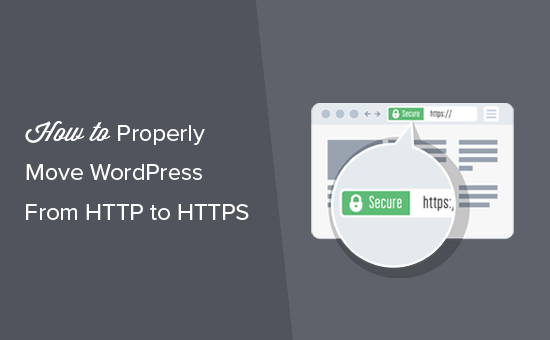
Ecco una rapida panoramica degli argomenti che tratteremo in questo articolo:
- What Is HTTPS?
- Why Do You Need HTTPS and SSL?
- Requirements for Using HTTPS/SSL on a WordPress Site
- Setting Up WordPress to Use SSL and HTTPS
- Method 1: Setup SSL/HTTPS in WordPress Using a Plugin
- Method 2: Set Up SSL/HTTPS in WordPress Manually
- Submit Your HTTPS Site to Google Search Console
- Bonus Resources
- Video Tutorial
Che cos’è l’HTTPS?
HTTPS, o Secure HTTP, è un metodo di crittografia che protegge la connessione tra il browser dell’utente e il vostro server. Questa maggiore sicurezza rende molto più difficile per gli hacker intercettare i dati trasferiti.
Ogni giorno le persone condividono i propri dati personali con i siti web, sia che stiano effettuando acquisti sia che stiano semplicemente effettuando il login. Abbiamo visto in prima persona quanto sia cruciale proteggere questo tipo di scambio di dati.
Per garantire la sicurezza dei dati, è necessario stabilire una connessione sicura.
È qui che entrano in gioco SSL e HTTPS.
Ogni sito web riceve un certificato SSL unico per l’identificazione. Se un server tenta di utilizzare HTTPS senza un certificato valido o se il certificato non corrisponde, la maggior parte dei browser moderni avvisa gli utenti e consiglia loro di non procedere.
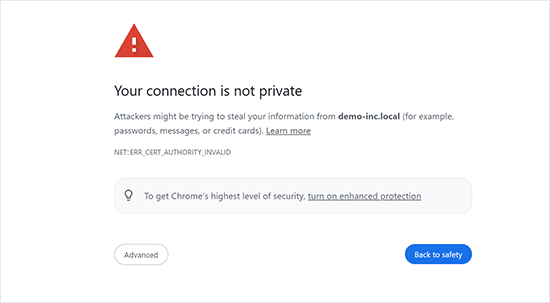
Ora, potreste chiedervi perché sia necessario spostare il vostro sito WordPress da HTTP a HTTPS, soprattutto se si tratta di un semplice blog o di un sito web di una piccola azienda che non effettua pagamenti.
Perché avete bisogno di HTTPS e SSL?
Nel 2018 Google ha annunciato un’iniziativa per aumentare la sicurezza del web, esortando i proprietari di siti a passare da HTTP a HTTPS. Per supportare questa mossa, il browser Chrome ha iniziato a contrassegnare tutti i siti web senza un certificato SSL come “Non sicuro”.
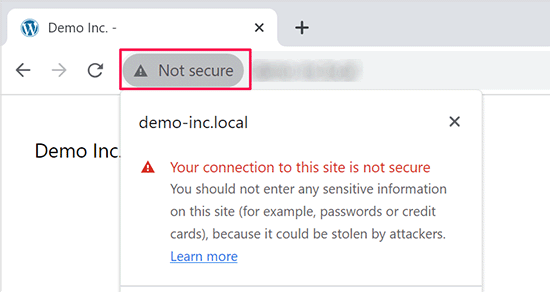
Google ha anche detto che i siti con SSL avrebbero ricevuto vantaggi SEO e avrebbero potuto ottenere un posizionamento di ricerca più alto rispetto ai siti non sicuri. Questo annuncio ha spinto molti proprietari di siti a passare all’HTTPS.
Una volta diffuso l’avviso “Non sicuro”, Chrome ha iniziato a segnalare i siti HTTP. Ad esempio, visitando un sito HTTP in modalità incognito o compilando un modulo di contatto su un sito HTTP si attiva l’avviso, contrassegnandolo come non sicuro.
Quando i visitatori vedono questo avviso, possono lasciare un’impressione negativa del vostro sito o della vostra azienda.
Per questo motivo tutti i siti web devono passare all’HTTPS e installare l’SSL il prima possibile.
Inoltre, l’SSL è indispensabile se si desidera accettare pagamenti online sul proprio sito di e-commerce.
I fornitori di pagamenti come Stripe, PayPal Pro e Authorize.net richiedono una connessione di pagamento sicura.
Ci assicuriamo che i nostri siti utilizzino l’SSL, compresi WPBeginner, OptinMonster, WPForms e MonsterInsights.
Requisiti per l’utilizzo di HTTPS/SSL su un sito WordPress
I requisiti per l’utilizzo di SSL in WordPress non sono molto elevati. Tutto quello che dovete fare è acquistare un certificato SSL, che potreste già avere gratuitamente.
Le migliori società di hosting WordPress offrono certificati SSL gratuiti a tutti i loro utenti:
Per maggiori dettagli, consultate la nostra guida su come ottenere un certificato SSL gratuito per il vostro sito WordPress.
Se il vostro ospitato non offre un certificato SSL gratuito, dovrete acquistarne uno.
Raccomandiamo Domain.com perché offre la migliore offerta di certificati SSL normali e wildcard.
Acquistando un certificato SSL, si ottiene anche un sigillo TrustLogo per il proprio sito web. Ogni certificato SSL viene fornito con una garanzia di sicurezza minima di 10.000 dollari. I prezzi partono da 33 dollari all’anno e i certificati SSL vengono rinnovati automaticamente.
Una volta acquistato un certificato SSL, dovrete chiedere al vostro provider di hosting di installarlo per voi.
Avete bisogno di aiuto per impostare l’SSL e passare all’HTTPS?
Se non avete tempo per impostare l’SSL, il nostro servizio diassistenza Premium WordPress è qui per aiutarvi! Possiamo gestire l’intero processo per voi, assicurandovi che il vostro sito sia sicuro e pronto per i visitatori.
- Tassa una tantum
- Tempi di consegna rapidi
- Disponibile su richiesta 24 ore su 24, 7 giorni su 7
Potete stare tranquilli sapendo che il vostro sito è in mani esperte. Contattateci oggi stesso per un’installazione SSL e una migrazione HTTPS senza problemi!
Impostazione di WordPress per l’utilizzo di SSL e HTTPS
Dopo aver abilitato un certificato SSL per il vostro dominio, dovrete impostare WordPress per utilizzare i protocolli SSL e HTTP sul vostro sito web.
Vi mostreremo due metodi per farlo e potrete scegliere quello più adatto alle vostre esigenze.
Metodo 1: Impostare SSL/HTTPS in WordPress utilizzando un plugin
Questo metodo è più semplice ed è consigliato ai principianti.
Per prima cosa, è necessario installare e attivare il plugin Really Simple SSL. Per maggiori dettagli, consultate la nostra guida passo passo su come installare un plugin di WordPress.
Dopo l’attivazione, è necessario visitare la pagina Impostazioni ” SSL. Il plugin rileverà automaticamente il vostro certificato SSL e imposterà il vostro sito WordPress per l’utilizzo di HTTPS.
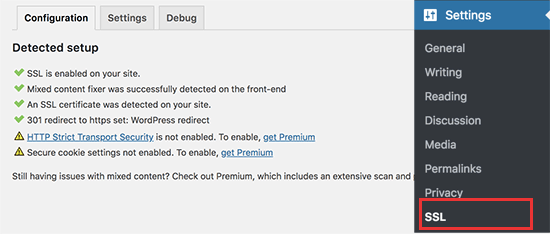
Il plugin si occuperà di tutto, compresi gli errori di contenuto misto. Ecco cosa fa il plugin dietro le quinte:
- Controllare il certificato SSL
- Impostate WordPress per utilizzare https negli URL
- Impostazione di reindirizzamenti da HTTP a HTTPS
- Cercate nei vostri contenuti gli URL che vengono ancora caricati da fonti HTTP non sicure e cercate di risolverli.
Nota: il plugin tenta di risolvere gli errori di contenuto misto utilizzando una tecnica di buffering dell’output. Questo può avere un impatto negativo sulle prestazioni, perché sostituisce il contenuto del sito mentre la pagina viene caricata. Questo impatto è visibile solo al primo caricamento della pagina e dovrebbe essere minimo se si utilizza un plugin per la cache.
Anche se il plugin dice che è possibile mantenere SSL e disattivare il plugin in modo sicuro, non è vero al 100%. Dovrete lasciare il plugin sempre attivo perché la disattivazione del plugin riporterà gli errori di contenuto misto. Per maggiori dettagli, consultate la nostra recensione di Really Simple SSL.
Metodo 2: Impostazione manuale di SSL/HTTPS in WordPress
Questo metodo richiede la risoluzione manuale dei problemi e la modifica dei file di WordPress. Tuttavia, è una soluzione permanente e più ottimizzata dal punto di vista delle prestazioni e la stiamo utilizzando su WPBeginner.
Se trovate questo metodo difficile, dovreste assumere uno sviluppatore WordPress o utilizzare il primo metodo.
Potrebbe essere necessario modificare il tema di WordPress e i file di codice come parte di questo metodo. Se non l’avete mai fatto prima, consultate la nostra guida su come copiare e incollare frammenti di codice in WordPress.
Per prima cosa, è necessario visitare la pagina Impostazioni ” Generale. Da qui, è necessario aggiornare i campi dell’indirizzo URL di WordPress e del sito sostituendo http con https.
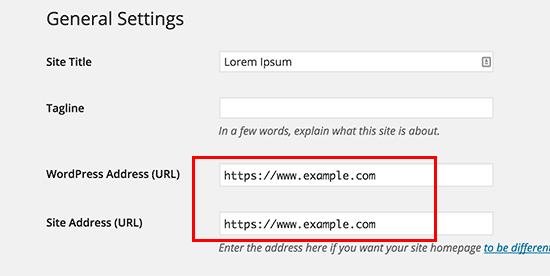
Non dimenticate di fare clic sul pulsante “Salva modifiche” per memorizzare le impostazioni.
Una volta salvate le impostazioni, WordPress vi farà uscire e vi chiederà di effettuare nuovamente il login.
Successivamente, è necessario impostare il reindirizzamento di WordPress da HTTP a HTTPS aggiungendo il seguente codice al file .htaccess:
1 2 3 4 5 | <IfModule mod_rewrite.c>RewriteEngine OnRewriteCond %{HTTPS} offRewriteRule ^(.*)$ https://%{HTTP_HOST}%{REQUEST_URI} [L,R=301]</IfModule> |
Se si utilizzano server NGINX, è necessario aggiungere il seguente codice per reindirizzare da HTTP a HTTPS nel file di configurazione:
1 2 3 4 5 | server {listen 80;server_name example.com www.example.com;return 301 https://example.com$request_uri;} |
Non dimenticate di sostituire example.com con il vostro nome di dominio.
Seguendo questi passaggi, eviterete l’errore WordPress HTTPS not working perché WordPress ora caricherà l’intero sito web utilizzando HTTPS.
Se si desidera forzare SSL e HTTPS nell’area di amministrazione di WordPress o nelle pagine di login, è necessario configurare SSL nel file wp-config.php.
Aggiungete il seguente codice sopra la riga “That’s all, stop editing!” nel file wp-config.php:
1 | define('FORCE_SSL_ADMIN', true); |
Questa riga consente a WordPress di forzare SSL/ HTTP nell’area di amministrazione di WordPress. Funziona anche sulle reti multisito di WordPress.
Una volta eseguita questa operazione, il sito web è completamente configurato per l’utilizzo di SSL/ HTTPS, ma si verificheranno ancora errori di contenuto misto.
Questi errori sono causati da fonti (immagini, script o fogli di stile) che vengono caricate utilizzando il protocollo HTTP non sicuro negli URL. In questo caso, non è possibile vedere l’icona del lucchetto sicuro nella barra degli indirizzi del sito web.
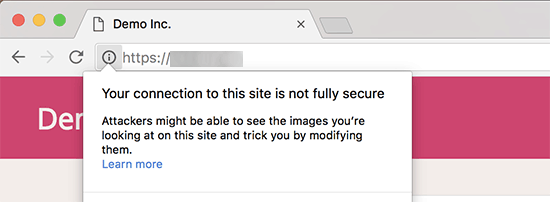
Molti browser moderni bloccano automaticamente gli script e le risorse non sicure.
Potreste vedere un’icona a forma di lucchetto, ma con una notificazione su chi siamo, nella barra degli indirizzi del browser.
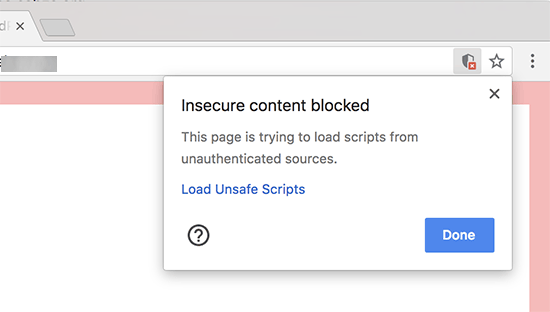
È possibile scoprire quali contenuti sono serviti attraverso un protocollo non sicuro utilizzando lo strumento Inspect.
L’errore di contenuto misto viene visualizzato come un’attenzione nella console con dettagli per ogni elemento di contenuto misto.
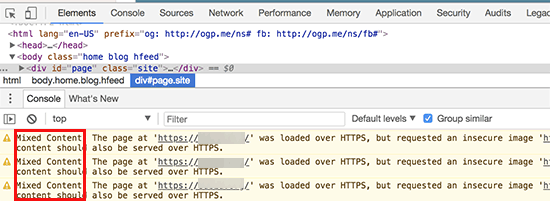
Si noterà che la maggior parte degli URL sono immagini, iframe e gallerie di immagini, mentre alcuni sono script e fogli di stile caricati dai plugin e dai temi di WordPress.
Correggere il contenuto misto nel database di WordPress
La maggior parte degli URL errati sono immagini, file, embed e altri dati memorizzati nel database di WordPress. Per prima cosa correggiamoli.
La cosa migliore sarebbe trovare nel database tutte le menzioni del vecchio URL del sito web che iniziano con HTTP e sostituirle con il nuovo URL del sito web che inizia con HTTPS.
È possibile farlo facilmente installando e attivando il plugin Search & Replace Everything. Per maggiori dettagli, consultate la nostra guida passo-passo su come installare un plugin di WordPress.
Dopo l’attivazione, è necessario visitare la pagina Strumenti ” WP Search & Replace. Nel campo “Cerca”, dovete aggiungere l’URL del vostro sito web con http. Successivamente, aggiungere l’URL del sito web con https nel campo “Sostituisci”.
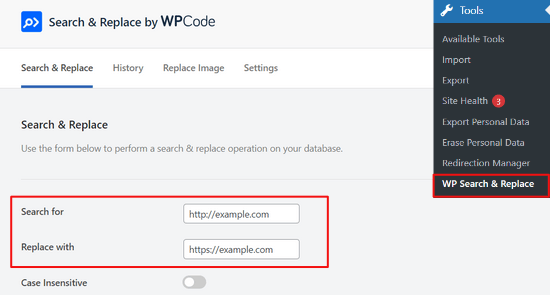
Di seguito, vengono visualizzate tutte le tabelle del database di WordPress.
È necessario selezionarli tutti per eseguire una verifica approfondita.
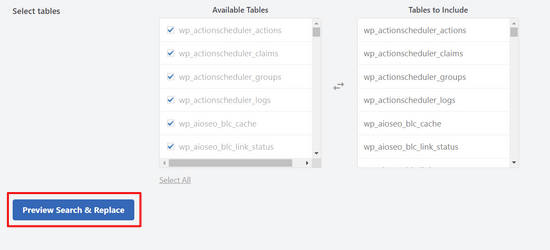
Quindi, fare clic sul pulsante “Anteprima di ricerca e sostituzione” per vedere tutte le modifiche apportate dal plugin.
Infine, fare clic sul pulsante “Sostituisci tutto”.
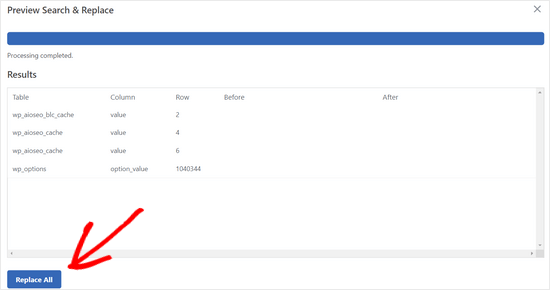
Il plugin cercherà ora nel database di WordPress gli URL che iniziano con http e li sostituirà con URL sicuri https. Potrebbe essere necessario un po’ di tempo, a seconda delle dimensioni del database di WordPress.
Correzione degli errori di contenuto misto nel tema WordPress
Un’altra causa comune degli errori di contenuto misto è il tema di WordPress. Qualsiasi tema WordPress decente che rispetti gli standard di codifica di WordPress non causerà questo problema.
Per prima cosa, è necessario utilizzare lo strumento di ispezione del browser per trovare le risorse e la loro provenienza.
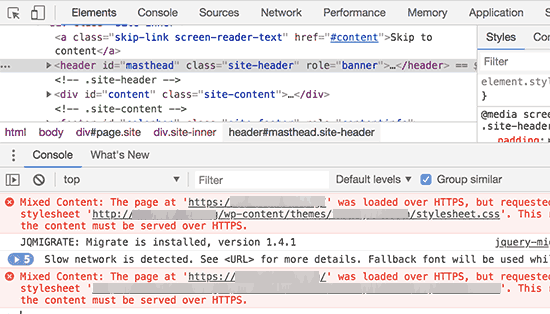
Successivamente, dovrete trovarli nel vostro tema WordPress e sostituirli con https. Questa operazione sarà un po’ difficile per la maggior parte dei principianti, poiché non sarà possibile vedere quali file del tema contengono questi URL.
Correzione degli errori di contenuto misto causati dai plugin
Alcune risorse a contenuto misto vengono caricate dai plugin di WordPress. Qualsiasi plugin di WordPress che rispetti gli standard di codifica di WordPress non causerà errori di contenuto misto.
Non consigliamo di modificare i file dei plugin di WordPress. Dovreste invece contattare l’autore del plugin e farglielo sapere. Se non rispondono o non sono in grado di correggere il problema, è necessario trovare un’alternativa adeguata.
Nota: se per qualche motivo si verifica ancora un errore di contenuto misto, si consiglia di utilizzare temporaneamente il plugin Really Simple SSL, in modo che gli utenti non ne risentano mentre si corregge il problema su un sito web di staging o si assume uno sviluppatore.
Inviate il vostro sito HTTPS a Google Search Console
I motori di ricerca come Google considerano https e http come due siti web diversi. Per evitare problemi di SEO, è necessario comunicare a Google che il sito web è stato spostato.
Per farlo, è sufficiente accedere all’account di Google Search Console e fare clic sul pulsante “Aggiungi proprietà”.

Si aprirà una finestra a comparsa in cui dovrete aggiungere il nuovo indirizzo https del vostro sito web.
Esistono due metodi per la verifica del sito: il nome di dominio o il prefisso URL. Consigliamo il metodo del prefisso URL perché è più flessibile.
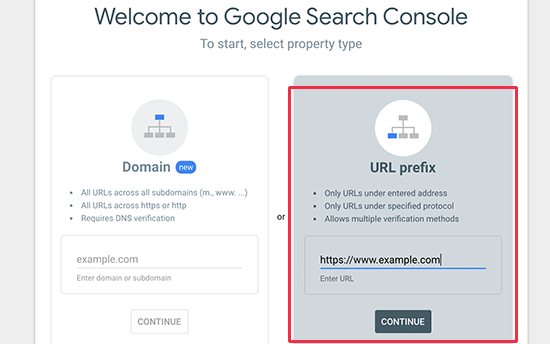
Successivamente, Google vi chiederà di verificare la proprietà del vostro sito web.
Ci sono diversi modi per farlo. Selezionate un metodo qualsiasi e riceverete le istruzioni per verificare il vostro sito. Si consiglia di utilizzare il metodo dei tag HTML.
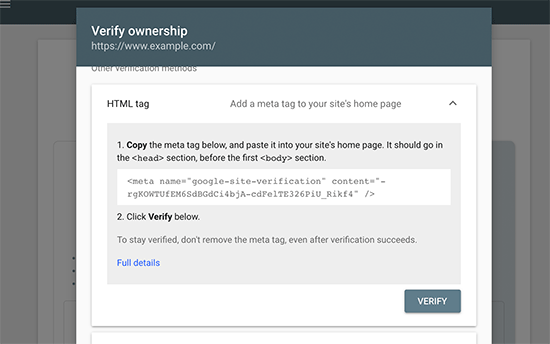
Ora vedrete uno snippet di codice HTML da aggiungere alla sezione head del vostro sito web WordPress.
Aggiungere il codice di verifica di Search Console utilizzando All in One SEO
Innanzitutto, installate e attivate il plugin All in One SEO for WordPress. Per maggiori dettagli, consultate il nostro tutorial su come installare un plugin di WordPress.
Nota: esiste anche una versione gratuita di All in One SEO che potete provare.
Dopo l’attivazione, accedere alla pagina All in One SEO ” Impostazioni generali e fare clic su Google Search Console.
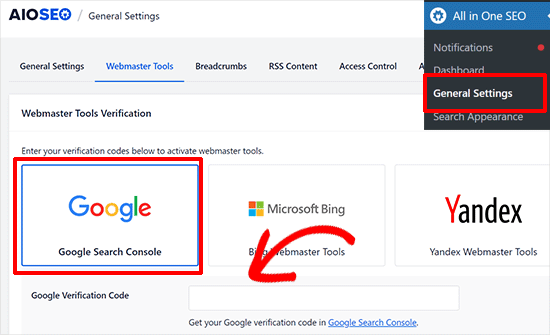
In seguito, è necessario aggiungere il codice di verifica copiato in precedenza dal sito web di Google Search Console.
Non dimenticate di cliccare sul pulsante “Salva modifiche” per memorizzare le impostazioni.
Quindi, tornare alla scheda Google Search Console e fare clic sul pulsante “Verifica”.
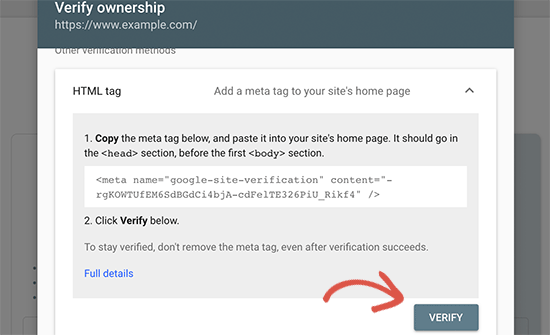
Una volta che il sito è stato verificato, Google mostrerà qui i rapporti della Search Console.
È inoltre necessario assicurarsi che entrambe le versioni https e http siano aggiunte alla Search Console.
Questo indica a Google che volete che la versione https del vostro sito web sia trattata come la versione principale. In combinazione con i reindirizzamenti 301 impostati in precedenza, Google trasferirà le classifiche di ricerca alla versione https del vostro sito web e molto probabilmente vedrete dei miglioramenti nelle vostre classifiche di ricerca.
Risorse bonus
Di seguito sono riportate alcune risorse aggiuntive che possono aiutarvi a risolvere da soli i problemi comuni di WordPress e a saperne di più su WordPress:
- Come correggere i problemi SSL più comuni in WordPress (Guida per principianti)
- Gli errori più comuni di WordPress e come risolverli
- TLS vs SSL: quale protocollo utilizzare per WordPress?
- Come correggere l’errore di connessione sicura in WordPress
Video tutorial
Speriamo che questo articolo vi abbia aiutato ad aggiungere HTTPS e SSL in WordPress. Potreste anche voler consultare la nostra guida definitiva alla sicurezza di WordPress con istruzioni passo-passo per mantenere sicuro il vostro sito WordPress o come rinnovare il vostro certificato SSL.
Se questo articolo vi è piaciuto, iscrivetevi al nostro canale YouTube per le esercitazioni video su WordPress. Potete trovarci anche su Twitter e Facebook.





Raul
Hi,
I’m in a predicament due to lack of knowledge and Google. My website is currently ranked # 2 in Google for a particular organic keyword. I ordered a SSL from my hosting company and I received confirmation that the SSL is ready to be used. I would like to use the SSL on every page in my site including the shopping cart but I don’t want to lose the #2 ranking in Google by not converting to SSL properly. Your advice will be appreciated.
Raul
Jonathon Fowler
Hi there,
Great article. One question, I read that using a wildcard redirect will have a negative impact on SEO – is this correct? The articel says ranking will drop using a wildcard redirect.
I have thousands if images on my site using http in the url…using yur redirect would direct all images to the new https?
Thanks !
WPBeginner Support
No, the whole purpose of redirects is to help with SEO and avoid negative impact of changed URLs. This is the method recommended by search engines themselves.
Admin
dylan
Hi,
I love your site – lots of good stuff here.
I’m wondering if you can recommend a wordpress security plug-in that you know for sure plays friendly (without too much hassle) with full site SSL / HTTPS.
My site is covered already (every page) but I’m worried about installing a plug-in that may interfere.
Any suggestions would be much appreciated.
Cheers
WPBeginner Support
We use Sucuri on WPBeginner and all other websites that we manage.
Admin
turan
Thank you very much everything solved by adding above code to .htaccess file
Joe
Will changing the Site URL in WordPress to “HTTPS” auto redirect any HTTP requests?
We don’t need htaccess rewrites if the SITE URL is HTTPS?
Cristi Scutaru
Great post, it helped me switch my WordPress site to SSL in just a few minutes!
Great site as well, congrats for such a valuable content. I found myself often googling for some WordPress related answers for the past few days, and your pages came on top frequently, with clear and concise solutions.
WPBeginner Support
Thanks, glad you found it helpful.
Admin
Piet
When only switching the WP backend to SSL, the next challenge is how to show featured images in the backend? These are loaded via http instead of https and as such do not show in the WP backend anymore.
Is there a way to load them from https for the backend only or do I just have to accept the fact that I will not be able to see them (in the backend)?
Tushar
Good article. Why don’t you use https on WPBegineer?
WPBeginner Support
We don’t use it right now but may be in future.
Admin
Yuvraj Khavad
Hi Team wpbeginner,
Thanks for this post. You save my time.
Keep Good Work.
Thanks
Yuvraj R K.
Logan
Thanks for this great guide to setting up https. Was using the plugin your mentioned for a long time but it caused problems with my site so I only used it to secure my admin panel. Now I can cover my entire site.
Felix Figueroa
The .htaccess edit broke my site with the “ERR_TOO_MANY_REDIRECTS” message. Tried suggestions detailed in this post. After disabling all plugins i get a 500 Server Error. Thanks, my site is completely broken now.
Eivind F Skjellum
Thanks, very helpful. Got my ssl working thanks to you!
Eivind
beamkiller
Dear wpBeginner,
I have made the modifications in htaccess and Options too but I got error in Chrome:
ERR_TOO_MANY_REDIRECTS
So my page is not secured with SSL, on Checkout and My-Account it is working with WooCommerce. But I cannot get to work it on the whole WP installation.
MMPrint
Hope this helps:
Uncheck the WooCommerce “Un-force HTTPS when leaving the checkout” setting.
The htaccess if forcing https but then woocommerce forces http so they just go back and forth in a loop.
Chetan
Hi MMPrint
I can give thousand thumbs up to your answer. This has solved my issue which i was living with since the last 10 days. No matter what i tried in the .htaccess file the site wasnt showing up. I also played with deactivating the plugins etc etc. Finally it was woocommerce which was the culprit.
Thanks a lot man !
Cheers
Chetan
Kevin Verlinden
I like this site the information is very useful and comprehensive. It has helped me already a lot of times.
Austin
Hey – any reason SSL is not being used on Optinmonster etc like mentioned in the article?
WPBeginner Support
SSL is used on OptinMonster website when users login or signup.
Admin
Austin
“We already use SSL for our eCommerce sites like OptinMonster, Soliloquy, and Envira Gallery.”
I took this to mean all of the pages – wondering if that was the case and now for some reason it has been reverted to non-SSL?
Thanks!
Armando Landois
I followed this guide and now my domain is working at
George
I tried this plugin and it broke my site. Uninstalled in immediately. I still need what this plugin offered, which is https on some pages, but not the whole site. Is there any other plugin (other than this one, which hasn’t been updated in over two years) that can do this?
Patrick
The free version of iThemes Security will take care of this for you
Celeste
What do you mean, Patrick, that iThemes Security will take care of this. I just went to their website and it seems like a good plugin for enhanced security. But I didn’t see any reference to SSL or setting up specific pages to use SSL only.
Octavio Cestari
I did the installation of a plugin which forced all the site enter https, now I can no longer access the site or the wordpress dashboard, how do I reverse the process?
Drew
I just added the code using your .htaccess solution. Worked perfectly and exactly as described. A big thank you!
michael s
You say all you need to do is buy a certificate, but my hosting service requires a static IP address also which is WAY more expensive than a basic certificate. My service wants $4/month for static IP.
DJ
HELP!
I did this change and now I can’t access my site through WP-ADMIN
It is stating my site is down. I don;t have an .htaccess file in my files. I have set FileZilla to show hidden files and cannot find it. Can you help me get back into my site?
Thanks.
WPBeginner Support
First try to deactivate all your plugins this should resolve your issue, but if it doesn’t then see our guide
Admin
DJ
I cannot get in to deactivate any plugins.
DJ
What Guide?
DJ
OK, added the htaccess file and added the code you have above but I still cannot get in.
Any ideas? All I’m seeing is a message saying my site does not exist.
DJ
David Coombes
DJ
Not sure if you are still having an issue but if you google ‘a plugin broke my site’ or something similar then there’s some good answers – basically it involved removing the plugins folder which should get your site back then reactivating the plugins one by one.
Hope it helps – it’s frustrating when a site goes down.
Sasha
I used the .htaccess method and got this error:
“The page isn’t redirecting properly
Firefox has detected that the server is redirecting the request for this address in a way that will never complete.
This problem can sometimes be caused by disabling or refusing to accept cookies.”
Any one has an idea?
thanks
Mike S
I added the code into the .htaccess and I got the following issue:
The page isn’t redirecting properly
Firefox has detected that the server is redirecting the request for this address in a way that will never complete.
This problem can sometimes be caused by disabling or refusing to accept cookies.
Marych
PLEASE HELP
I didn t get a certificate but just went to settings > General and replaced http by https .
after updating I can t access to my wordpress url and the message ‘ Your connection is not private
Attackers might be trying to steal your information from etlco.com.sa (for example, passwords, messages, or credit cards). ‘ is displayed .
Any solution , please help me
Andron
You need to get a certificate in order for it to work. When you request a page over https, it starts a conversation between your browser and the server in which the server validates its identity as the correct site. That validation occurs by sending a trusted certificate to your browser. If a certificate doesn’t exist, your browser will give you that “connection is not private” warning. It’s done to protect you from sites that aren’t who they claim to be.
Namecheap offers basic SSL certificates for $9 a year, and there are plenty of other options. If you can wait, look into LetsEncrypt.org — they’ll be offering free ones starting this September, I think.
sewe herbert
Hi Marych, just had that same problem, but managed to fix it; here is how
use an FTP Program, alocate the wp-config.php
then put this just after (define(‘ABSPATH’, dirname(__FILE__) . ‘/’);)
define(‘WP_HOME’,’http://yoursite.com’);
define(‘WP_SITEURL’,’http://yoursite.com’);
then save and re-upload the wp-config.php file
Then all is well
Gary Morrison
We have did like you said .. and not we are locked out of the dashboard and any page we go to on front end will not display only home page works.
Thank you for your time ..
P.S. and now my images are not showing up…
WPBeginner Support
Please retry all the steps in the article again. If the problem persists contact your web hosting service provider.
Admin
Gary Morrison
There was a problem on Hosting side with the migration to SSL server..
All is good TY
Tom L
Thank you very much for your support. I was able to install the plugin and have my site with all pages https without any adjustments.
Perfect instructions.
Tecnologia Geek
nice..is working now..how i make this to show the green bar?
Tecnologia Geek
can i have some help here.. i dit all this step but..the site look diferent and i cant login to admin..
Maarten
It is worth mentioning this technique breaks WooCommerce downloads. It will end in a 403 access denied for forced download or x-sendfile downloadable products.
Matthew
Thanks for the excellent article.
I was under the impression that installing an SSL certificate was as simple as you have indicated… however, when I installed mine it appears to confused (and completely broken) my site. I am being told that some parts of my wordpress database have changed to https, but others haven’t.
Now I can’t get in to the wordpress admin area at all – but I can ftp to the hosting.
Any ideas how I can update my wordpress databases and themes to reflect https rather than http ?
I am tempted to uninstall the certificate, restore my entire site from a backup and wander off, shaking my head in frustration.
Thanks,
Matthew
Shane
Your article made no mention of verifying plugin compatibility with SSL before making the change. Is that because plugin code generally doesn’t go “offsite” and hence result in “insecure” content warnings, or are plugins something that we should be concerned about and carefully review before considering the switch?
Jim R
thank you for this- never used SSL or HTTPS before and suddenly needed a java donations page to be HTTPS. with your instructions I was able to get it working in a matter of minutes.
Jennifer Goddard
Don’t download this plug in. As of late 2014 there are multiple complaints of incompatibility!
GJ
Thanks for the tutorial.
I wanted to add a few more resources..
1) Change all the ur’s media/js etc through the Bluevelvet plugin from http to https
2) if you do not have the green https color you can look for insecure files at whynopadlock.com
3) Submit your https version to the webmaster tools as well
Kevin Donnigan (@anythinggraphic)
Very good additional tips. Appreciate it.
Amr
Ahh All what i needed bro you’re the man!
Ollie
Excellent tips as always.
I’d like to point out for anyone using the .htaccess redirect, to include that in their htacces file first at the top. I had the usual wordpress htaccess code at the top of the file and it wasn’t working until I pasted the new code before it.
Johny P
Really now a days ssl is moving to a new level . Awesome article.
Rael
hi guys,
I have an http link which cannot be changed using //www.url.com/ because the server it’s on doesn’t have SSL.
The issue comes when this link appears on a secure page on my site.
Is there a way to redirect it to http once off the https page?
WPBeginner Staff
Contact W3 Total Cache support.
Muhammad Umer
Hi Syed i really need your help in this, some plugin causing this i added this today more than 5 times after few time it remove automatically from htaccess file, i am using w3 total cache.
Muhammad Umer
Hi, Thank you for the guide i configured everything perfectly with your guide, but when i empty cache or use w3 total cach plugn they removed my .htaccess file and start their own.
is there any settings in the plugin?
currently want to use ssl on
Thanks,
WPBeginner Staff
Yes, we do.
Mark
Hi, the WordPress HTTPS plugin hasn’t been updated in a couple of years. Do you still recommend it?
WPBeginner Staff
Your site is making http requests to resources which are not secure. For example many WordPress themes fetch Google fonts using a non-https url. View your site’s source code to figure out which scripts, images, stylesheets are using non-https URLs.
Dustin
Very helpful. SSL works great on my sites now. The main issue I ran into was securing images. Easy to identify, but time-consuming to fix. It seems all I had to do was reload the same image and it fixed the problem. For sites that have hundreds or more images, is there a plugin or an easier way you’d recommend to fix insecure images? Thank you.
Gavin
Like Justin, the biggest issue I had was with images. I’m currently running SSL Insecure Content Fixer plugin with the ‘Content’ option checked to resolve this issue, but it’s unsatisfactory to have to have a plugin activated all the time instead of just being able to apply a change from http to https to images across the board (perhaps other media types too? – I haven’t check this). Is there a way to apply a universal permanent change? Thanks.
Travis Pflanz
One of the biggest culprits of elements not being loaded over HTTPS is a theme calling Google Fonts. Unfortunately, many theme developers call the Google font with http://, rather than just //
WPBeginner Staff
Seems like your website has some elements loaded from a non secure URL. Most probably a third party script or stylesheet.
Heri Saputra
Hi.. I have been installed comodo ssl to my site but ssl on my site is not green light, how I can fix it?
Heri Saputra
Hi,,, I have been installed ssl to my website but my ssl is not green light but like this, how I can fix it? Tx
WPBeginner Staff
We will be moving all our sites to SSL and HTTPs very soon.
Matthew Bochnak
Thanks for posting this! I had to go through this process and could not figure out the redirect from http to https.
Techno-Proo.com
why you don’t use SSL and HTTPS ?